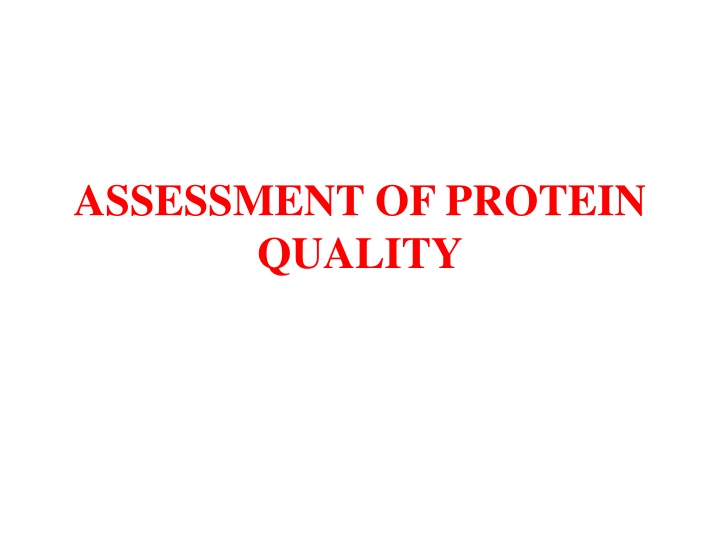
Protein Quality Assessment Parameters
Learn about the various methods for assessing protein quality, including Amino Acid Score, Protein Efficiency Ratio, Digestibility Co-efficient, Biological Value, Urinary Nitrogen, Net Protein Utilization, and Protein Energy Ratio.
Download Presentation

Please find below an Image/Link to download the presentation.
The content on the website is provided AS IS for your information and personal use only. It may not be sold, licensed, or shared on other websites without obtaining consent from the author. If you encounter any issues during the download, it is possible that the publisher has removed the file from their server.
You are allowed to download the files provided on this website for personal or commercial use, subject to the condition that they are used lawfully. All files are the property of their respective owners.
The content on the website is provided AS IS for your information and personal use only. It may not be sold, licensed, or shared on other websites without obtaining consent from the author.
E N D
Presentation Transcript
ASSESSMENT OF PROTEIN QUALITY
Quality of protein assessed by comparison of protein to reference protein . usually egg protein.
AMINO ACID SCORE (AAS) Measure of concentration of each essential amino acid in the test protein expressed as percentage of that amino acid in the reference protein. Mg of one amino acid per gram of test protein AAS= Mg of same amino acid per gram of test protein
PROTEIN EFFICIENCY RATIO Growth of young albino rats observed over period of 28 days while fed on adequate diet containing test protein. PER is weight gain per gram of protein consumed. Weight gain in grams PER= Protein consumed in grams
DIGESTIBILITY CO-EFFICIENT (DC) Percentage of ingested nitrogen absorbed into blood stream after the process of digestion is complete. In (Fn-Fe) DC= X 100 In In = Nitrogen Intake Fn = Faecal Nitrogen Fe = Endogenous Faecal Nitrogen
BIOLOGICAL VALUE (BV) Percentage of absorbed nitrogen that is retained by body. Efficacy with which food proteins are used for body building/growth. Nitrogen Retained BV= X 100 Nitrogen Absorbed In- [(Un-Ue) + (FN-Fe)] BV= X 100 In-(Fn-Fe)
Un = Urinary nitrogen Ue = Endogenous Urinary Nitrogen A food stuff with BV 70 is sufficient for supporting growth provided calories are adequate.
NET PROTEIN UTILIZATION(NPU) Percentage of ingested nitrogen retained in body after complete digestion. Nitrogen retained in body NPU= X 100 Nitrogen intake DC X BV = 100 In [ (Un-ue) + (Fn-Fe)] = X 100 In
PROTEIN ENERGY RATIO (PE RATIO ) Percentage of energy provided by proteins out of total energy provided in diet. Energy from protein PE Ratio = X 100 Total energy in diet
EXCERCISE Two groups of animals were fed protein from three different sources-Rice, Wheat and Egg. From given below comment on quality of protein from 3 different sources based on their PER. Source of protein Initial After 4 weeks Body weight (gm) Food intake(gm) (in 4 weeks) Rice 62 92 3000 Wheat 62 112 300 Egg 62 137 300
Weight gain in grams PER= Protein consumed in grams PER (Rice)= 30/300= .1 PER (Wheat)= 50/300= .17 PER (Egg)= 75/300= .25
EXCERCISE Two group of guinea pigs were fed protein from two different sources i.e. Red Gram dal and Egg. Comment on quality of protein after assessing their Digestibility co-efficient. Values Red gram Dal (gm) Egg Food Nitrogen intake 10.0 10.0 Faecal Nitrogen 4.8 4.3 Endogenous Faecal Nitrogen Urinary Nitrogen 4.0 7.2 4.1 6.6 Endogenous Urinary Nitrogen 5.2 6.2
In (Fn-Fe) DC= X 100 In DC(Red Gram) = 10- (4.8-4.0) X100 10 =10-(.8) = 9.2 DC(Egg) = 10- (4.3-4.1) X100 10 =10-(.2) =9.8 Quality of protein of egg is better than Red gram on assessing Digestibility Co-efficient
EXCERCISE Two groups of guinea pigs were fed protein from two different sources i.e. Rice and Egg. Comment on quality of protein after assessing their Biological Value. Red gram Dal (gm) 8.0 Egg Value Food Nitrogen intake 8.0 Faecal Nitrogen 3.2 2.2 Endogenous Faecal Nitrogen Urinary Nitrogen 2.0 2.1 6.2 4.8 Endogenous Urinary 3.2 4.7
In- [(Un-Ue) + (FN-Fe)] BV (Rice) = X 100 In-(Fn-Fe) 8.0- [(6.2-3.2)+ (3.2-2.0) = X 100 8.0-(3.2-2.0) =8.0-[(3.0)+(1.2)] 8.0- (1.2) = 8.0-4.2 6.8 = 3.8/6.8 =0.56
